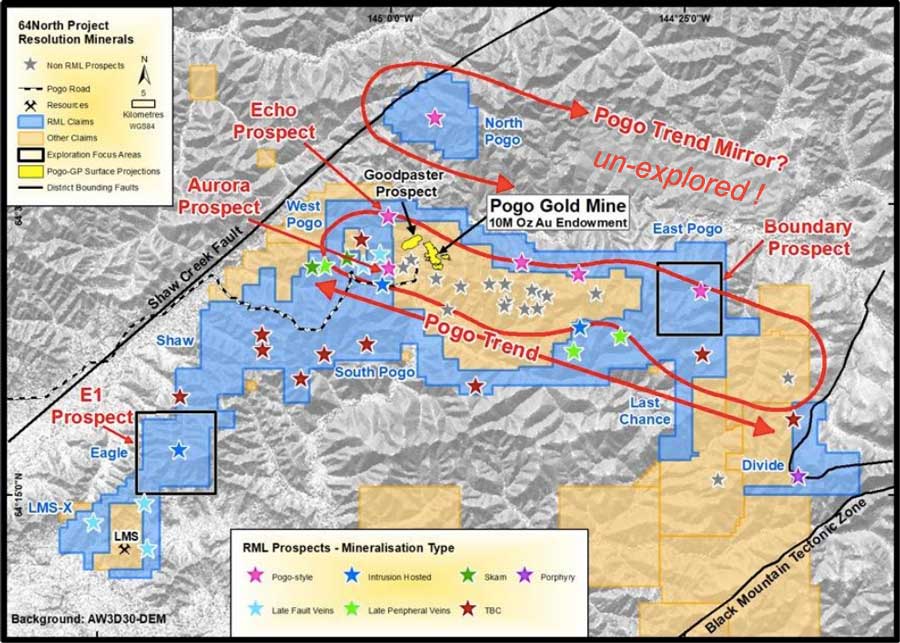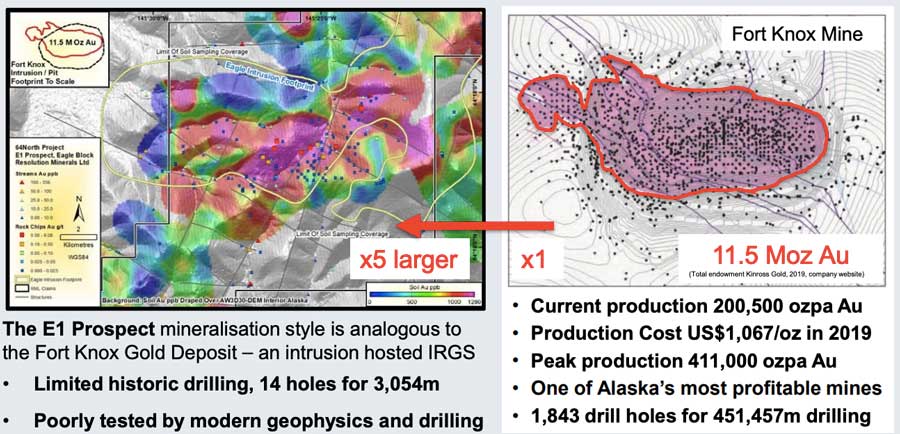Why Alaska is the overlooked exploration hotspot to be in

Pic: Tyler Stableford / Stone via Getty Images
Special Report: For a long time, there has been very little focus on Alaska as a prospective gold exploration jurisdiction, but that is changing quickly as some early mover companies show just what the region has to offer.
Even after big gold producer Northern Star Resources (ASX:NST) swooped in and bought the 10-million-ounce Pogo mine in Alaska in mid-2018, very few explorers realised the opportunity of this highly gold fertile region.
The Pogo mine is world class, beginning production in 2006 and producing ~300,000oz a year at +13 grams per tonne (g/t) gold, or around 4 million ounces, since then.
The very large and very well-endowed Tintina gold province that hosts Pogo is also home to other giant gold deposits such as the 11.5-million-ounce Fort Knox, 39-million-ounce Donlin and 12.6-million-ounce Livengood mines.

The Tintina gold province stretches 2,000km from the western coast of Alaska down into the Yukon.
“Most of the deposits that have been found in Alaska to date have been the ones that were sticking out of the ground, and they’re still finding them sticking out of the ground only within the last 20 years,” Duncan Chessell, managing director of ASX-listed Alaska-focused explorer Resolution Minerals (ASX:RML), told Stockhead.
“Alluvial mining is about half of the current historic production in Alaska. There’s been over a 100 million ounces of gold produced in Alaska over historically, about half from from alluvial plays and about 50 million ounces from lode gold of various deposit styles.
“There’s quite a few deposits in Alaska that have been discovered and there are some giant-sized deposits that are yet to be developed.”
It wasn’t until the late 80s/early 90s that modern exploration really started to be undertaken in the region.
And it wasn’t until the mid-90s that original Pogo mine owners Sumitomo and Teck unearthed the first of the main gold bearing zones within the Pogo mine.
“You can go probably 10km away from Pogo in many directions, especially to the north, and almost no exploration at all has been undertaken even though it’s the same geological terrain, the same rock, the same cretaceous granite,” Chessell explained.
Alaska is also now ranked the fourth most attractive mining jurisdiction by the Fraser Institute, shifting up from fifth spot in 2019.
Indicating the regional prospectivity of the Tintina province, in September last year Northern Star uncovered something big and high grade at the Goodpaster prospect near Pogo.
Now considered a continuation of the main Pogo mineralised trend, Goodpaster currently extends over a strike distance of 2.3km, to a depth of 500m, and remains open in every direction.
In very recent news Northern Star Resources Ltd Q&A Webinar discussing the June 2020 Quarterly Results. “At Pogo in addition to the in-mine expansion program, a significant investment will be made into the first stage of resource definition drilling into the core of the Goodpaster Area, where initial exploration drilling has outlined a 2.5km long mineralised corridor”, stated Michael Mulroney, Chief Geological Officer Northern Star Resources Ltd.
The Goodpaster Prospect is only 800m from RML boundary.
Good value opportunity while the market was looking the other way
In 2018-19 while Northern Star was still trying to work out how to turn production around at the Pogo mine not long after buying it, Canadian company Millrock Resources had been quietly amassing a significant landholding surrounding the Pogo mine.
Millrock is a project generator, meaning the company picks up a decent patch of ground, gathers some historic exploration data and then offers it up to potential partners as an earn-in project.
At the time though, Canadian (TSXV) investors weren’t interested in junior miners — crypto and cannabis were all the rage.
This meant Resolution Minerals was able to strike a very good value earn-in deal with Millrock, giving the company exposure to one or several potential Pogo lookalikes.
“I think what we’ve got is a very dominant ground position surrounding the Pogo gold mine and their main prospects,” Chessell said.
“We’ve certainly got in ahead of the rush that we’re seeing throughout Australia and North America now.”

Since striking the deal to earn-in to Millrock’s landholding, Resolution is fast proving the 64North project’s likeness to the Pogo mine.
The right rocks
Drilling at the compelling Aurora prospect has hit the same host rock as Northern Star’s Pogo mine.
Granitic intrusions are the main mineralising “engine room” of the Tintina province and are present within Resolution’s 64North project.
The Aurora Prospect is a large-scale, high-priority target zone (2km x 5km), with host rocks, surface geochemistry, structures and a geophysical signature that make it a lookalike to the Goodpaster prospect and Pogo gold mine.
In this vast underexplored region, Resolution has identified 30 prospects, of which the Aurora, Echo, E1 and Boundary prospects are a high priority focus for the company.
Hunting for the next Pogo or Fort Knox
Resolution is developing a pipeline of drilling targets from the numerous prospects identified from an extensive historic data review.
The company is awaiting the results of the latest two holes drilled at Aurora before potentially doing some follow-up drilling.
“The second hole was quite deep, chasing some good-looking rocks, and that’s probably in the right host rock and we were encouraged by what we saw,” Chessell said.
Resolution is sending a second drill rig up to the Echo prospect to undertake helicopter supported diamond core drilling of a couple of holes.
“We’ll also be commencing putting in a trail down to the E1 prospect to the south on the Eagle block to allow us to get onto what we think is a potential Fort Knox lookalike, a large intrusion-hosted type of mineralised system,” Chessell said.

Resolution also believes there is the potential for a Pogo lookalike at North Pogo and is preparing to do some early stage works.
“There’s also this Pogo trend that goes east to west and then there’s a sort of mirror potential version of it further to the north. There’s a big unexplored question mark,” Chessell noted.
“There’s been very few samples of anything taken. There’s virtually no soils done at all up there, there’s a couple of rock chips and I think about a dozen stream sediments over an area that’s 50km by 10km, and it’s potentially a complete mirror of the Pogo trend.”
Resolution has had such strong support for its mission to find the next multi-million-ounce gold mine in Alaska that it more than filled its recent $3.6m bookbuild within minutes of going to market.
The company received over $10m worth of bids within a couple of hours of launching its capital raising.
Leading North American gold fund, Palisades Goldcorp, is a cornerstone investor in the placement.
With junior resource equities valued at generational lows, Palisades believes the sector is on the cusp of a major bull market move. It is amassing significant stakes in undervalued companies and assets with the goal of generating superior returns.
The fresh cash injection will put Resolution firmly on track to earn its 30 per cent stake in the 64North project.
Resolution Minerals is hosting an investor webinar on July 28 at 11:30AM AEST.
This article was developed in collaboration with Resolution Minerals, a Stockhead advertiser at the time of publishing.
This article does not constitute financial product advice. You should consider obtaining independent advice before making any financial decisions.
Related Topics

UNLOCK INSIGHTS
Discover the untold stories of emerging ASX stocks.
Daily news and expert analysis, it's free to subscribe.
By proceeding, you confirm you understand that we handle personal information in accordance with our Privacy Policy.








